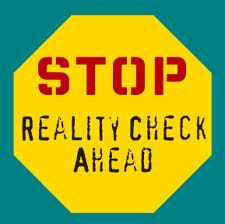 One of the problems with our caveman brains is that they are a bit slow. It may not feel that way but they are – and if you don’t believe me try this experiment: Stand up, get a book, hold it in your left hand open it at any page, hold a coin in your right hand between finger and thumb so that it will land on the floor when you drop it. Then close your eyes and count to three. Open your eyes, drop the coin, and immediately start reading the book. How long is it before you are consciously aware of the meaning of the words. My guess is that the coin hits the floor about the same time that you start to making sense of what is on the page. That means it takes about half a second to start perceiving what you are seeing. That long delay is a problem because the world around us is often changing much faster than that and, to survive, we need to keep up. So what we do is fill in the gaps – what we perceive is a combination of what we actually see and what we expect to see – the process is seamless, automatic and unconscious. And that is OK so long as expectation and reality stay in tune – but what happens when they don’t? We experience the “Eh?” effect which signals that we are temporarily confused – an uncomfortable and scary feeling which resolves when we re-align our perception with reality. Over time we all learn to avoid that uncomfortable confusion feeling with a simple mind trick – we just filter out the things we see that do not fit our expectation. Psychologists call this “perceptual distortion” and the effect is even greater when we look with our minds-eye rather than our real eyes – then we only perceive what we expect to see and we avoid the uncomfortable “Eh?” effect completely. This unconscious behaviour we all demonstrate is called self-delusion and it is a powerful barrier to improvement – because to improve we have to first accept that what we have is not good enough and that reality does not match our expectation.
One of the problems with our caveman brains is that they are a bit slow. It may not feel that way but they are – and if you don’t believe me try this experiment: Stand up, get a book, hold it in your left hand open it at any page, hold a coin in your right hand between finger and thumb so that it will land on the floor when you drop it. Then close your eyes and count to three. Open your eyes, drop the coin, and immediately start reading the book. How long is it before you are consciously aware of the meaning of the words. My guess is that the coin hits the floor about the same time that you start to making sense of what is on the page. That means it takes about half a second to start perceiving what you are seeing. That long delay is a problem because the world around us is often changing much faster than that and, to survive, we need to keep up. So what we do is fill in the gaps – what we perceive is a combination of what we actually see and what we expect to see – the process is seamless, automatic and unconscious. And that is OK so long as expectation and reality stay in tune – but what happens when they don’t? We experience the “Eh?” effect which signals that we are temporarily confused – an uncomfortable and scary feeling which resolves when we re-align our perception with reality. Over time we all learn to avoid that uncomfortable confusion feeling with a simple mind trick – we just filter out the things we see that do not fit our expectation. Psychologists call this “perceptual distortion” and the effect is even greater when we look with our minds-eye rather than our real eyes – then we only perceive what we expect to see and we avoid the uncomfortable “Eh?” effect completely. This unconscious behaviour we all demonstrate is called self-delusion and it is a powerful barrier to improvement – because to improve we have to first accept that what we have is not good enough and that reality does not match our expectation.
To become a master of improvement it is necessary to learn to be comfortable with the “eh?” feeling – to disconnect it from the negative emotion of fear that drives the denial reaction and self-justifying behaviour – and instead to reconnect it to the positive emotion of excitement that drives the curiosity action and exploratory behaviour. One ewasy way to generate the “eh?” effect is to perform reality checks – to consciously compare what we actually see with what we expect to see. That is not easy because our perception is very slippery – we are all very,very good at perceptual distortion. A way around this is to present ourselves with a picture of realilty over time, using the past as a baseline, and our understanding of the system, we can predict what we believe will happen in the near future. We then compare what actually happens with our expectation. Any significant deviations are “eh?” effects that we can use to focus our curiosity – for there hide the nuggets of new knowledge. But how do we know what is a “signifcant” deviation? To answer that we must avoid using our slippery self-delusional perception system – we need a tool that is designed to do this interpretation safely, easily, and quickly. Click here for an example of such a tool.
